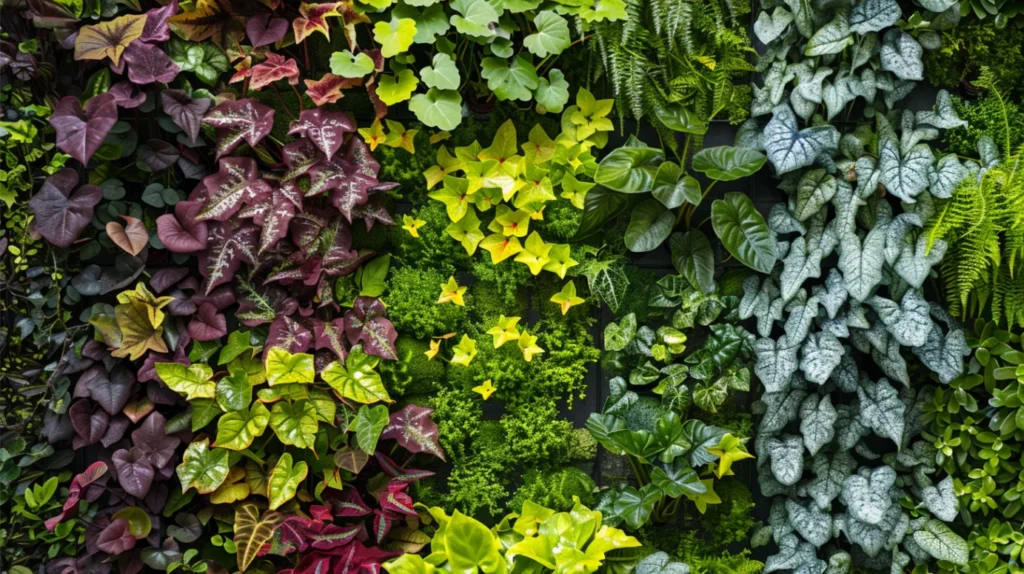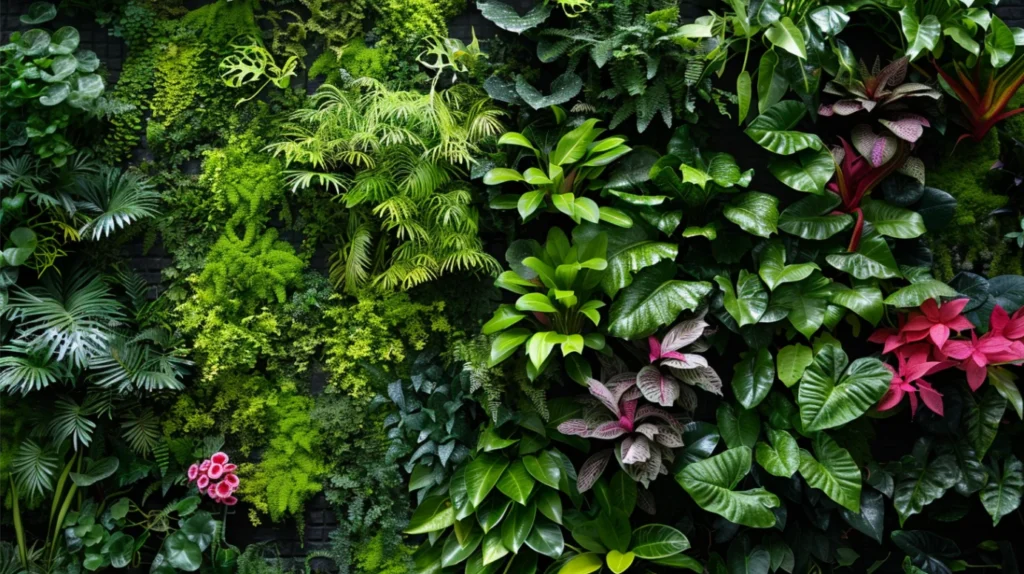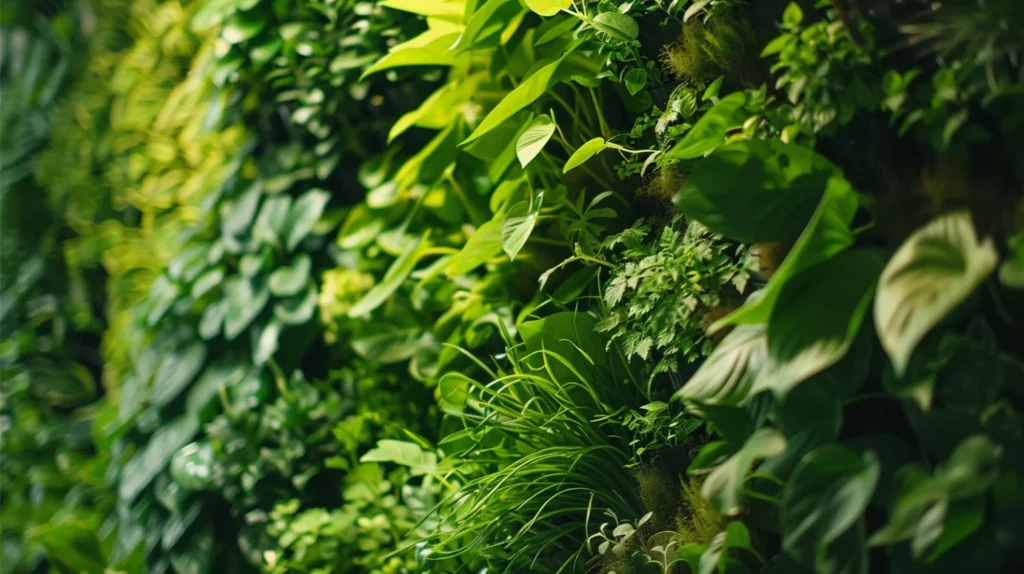Welcome, plant enthusiasts and home decor lovers! Are you ready to transform your living space into a lush, green oasis? If you’ve been dreaming of bringing the outdoors inside, an indoor living wall might be just what you need. In this comprehensive guide, we’ll explore everything you need to know about creating and caring for your very own vertical garden. So, let’s dive in and discover how to turn your walls into a thriving ecosystem!
What is an Indoor Living Wall?
Before we get into the nitty-gritty details, let’s start with the basics. An indoor living wall, also known as a vertical garden or green wall, is a self-sufficient vertical planting system that allows you to grow plants on a wall inside your home or office. These stunning installations not only add a touch of natural beauty to your space but also offer numerous benefits for your health and well-being.
Benefits of Indoor Living Walls
- Improved air quality
- Natural humidification
- Noise reduction
- Stress relief and improved mood
- Enhanced aesthetics and visual appeal
- Space-saving gardening solution
Now that we’ve covered the basics, let’s explore how you can create your own indoor living wall and keep it thriving for years to come.
Planning Your Indoor Living Wall

Before you start assembling your living wall, it’s essential to plan carefully. This will ensure that your project is successful and sustainable in the long run.
1. Choose the Right Location
The first step in creating your indoor living wall is selecting the perfect spot. Consider the following factors:
- Light availability: Most plants need adequate light to thrive. Choose a wall that receives sufficient natural light or be prepared to supplement with grow lights.
- Structural support: Ensure the wall can support the weight of your living wall system, plants, and soil.
- Proximity to water source: Easy access to water will make maintenance more convenient.
- Temperature and humidity: Avoid areas with extreme temperature fluctuations or drafts.
2. Determine Your Living Wall System
There are several types of living wall systems available, each with its own pros and cons. Some popular options include:
- Pocket systems
- Panel systems
- Tray systems
- Felt systems
Research each type to determine which best suits your needs, budget, and DIY skills. If you’re feeling overwhelmed, don’t hesitate to consult with a professional or check out resources on https://gardenandhomehacks.com for more guidance.
3. Select Your Plants
Choosing the right plants is crucial for the success of your indoor living wall. Consider the following when making your selection:
- Light requirements
- Watering needs
- Growth habits
- Toxicity (especially if you have pets or children)
- Visual appeal and texture
Some popular plant choices for indoor living walls include:
- Pothos (Epipremnum aureum)
- Philodendron
- Spider Plant (Chlorophytum comosum)
- Ferns (various species)
- Peace Lily (Spathiphyllum)
- English Ivy (Hedera helix)
- Fittonia (Nerve Plant)
- Peperomia
- Tradescantia (Wandering Jew)
Mix and match different species to create an interesting and visually appealing design. Remember to group plants with similar care requirements together for easier maintenance.
Creating Your Indoor Living Wall

Now that you’ve done your planning, it’s time to bring your vision to life! Here’s a step-by-step guide to creating your indoor living wall:
1. Prepare the Wall
Start by protecting your wall from moisture damage:
- Clean the wall thoroughly.
- Apply a waterproof sealant or membrane.
- Install a vapor barrier if needed.
2. Install the Living Wall System
Follow the manufacturer’s instructions to install your chosen living wall system. This may involve:
- Attaching a frame or mounting brackets to the wall.
- Securing the planting modules or panels to the frame.
- Installing an irrigation system (if applicable).
3. Prepare the Plants
Before planting, take these steps to ensure your plants are ready for their new vertical home:
- Remove plants from their nursery pots.
- Gently loosen the root balls.
- Trim any damaged or excessively long roots.
- If using a soil-based system, prepare a well-draining potting mix suitable for your chosen plants.
4. Plant Your Living Wall
Now for the fun part – planting your vertical garden!
- Start from the bottom and work your way up.
- Place plants according to your design plan, considering their growth habits and care requirements.
- Secure plants in place using the method appropriate for your living wall system.
- Add soil or growing medium as needed, ensuring roots are well-covered.
5. Add Finishing Touches
Complete your indoor living wall installation:
- Install any necessary lighting systems.
- Set up your irrigation system or watering schedule.
- Add decorative elements like rocks or bark to cover exposed soil or growing medium.
Caring for Your Indoor Living Wall

Congratulations on creating your indoor living wall! Now, let’s explore how to keep it lush and healthy.
Watering
Proper watering is crucial for the health of your living wall. Here are some tips:
- Check moisture levels regularly: Use a moisture meter or your finger to test the soil or growing medium.
- Water thoroughly: Ensure water reaches all plants, especially those at the top of the wall.
- Avoid overwatering: Good drainage is essential to prevent root rot.
- Consider an automatic irrigation system for larger walls or if you travel frequently.
Lighting
Most indoor plants require adequate light to thrive. If natural light is insufficient:
- Supplement with grow lights: LED grow lights are energy-efficient and effective for most plants.
- Rotate plants if some areas receive less light than others.
- Monitor for signs of insufficient light, such as leggy growth or pale leaves.
Fertilizing
Feed your plants to keep them healthy and vibrant:
- Use a balanced, water-soluble fertilizer suitable for indoor plants.
- Fertilize monthly during the growing season (spring and summer).
- Reduce fertilization in fall and winter when plant growth slows.
Pruning and Maintenance
Regular maintenance will keep your living wall looking its best:
- Prune regularly to control growth and maintain the desired shape.
- Remove dead or yellowing leaves promptly.
- Check for pests and diseases and treat promptly if detected.
- Clean leaves periodically to remove dust and allow for better light absorption.
Replacing Plants
Over time, you may need to replace some plants:
- Monitor for plants that are struggling or outgrowing their space.
- Have replacement plants ready to fill any gaps quickly.
- Consider seasonal rotations to keep your living wall fresh and interesting throughout the year.
Troubleshooting Common Issues
Even with the best care, you may encounter some challenges with your indoor living wall. Here are some common issues and how to address them:
1. Yellowing Leaves
- Possible causes: Overwatering, underwatering, nutrient deficiency, or insufficient light.
- Solution: Adjust watering, check drainage, fertilize if needed, or relocate to a brighter spot.
2. Pest Infestations
- Common pests: Spider mites, mealybugs, scale insects, and fungus gnats.
- Solution: Isolate affected plants, treat with neem oil or insecticidal soap, and improve air circulation.
3. Mold or Mildew
- Possible causes: Excessive moisture, poor air circulation.
- Solution: Reduce watering, improve ventilation, and remove affected parts of the plant.
4. Uneven Growth
- Possible causes: Inconsistent light or water distribution.
- Solution: Rotate plants, adjust watering techniques, or supplement with grow lights as needed.
5. Falling Plants
- Possible causes: Inadequate support, overgrown plants.
- Solution: Reinforce the living wall system, prune plants, or replace with more suitable species.
Conclusion: Embracing the Green Revolution
Creating and maintaining an indoor living wall is a rewarding experience that brings a piece of nature into your home. With proper planning, care, and attention, your vertical garden will thrive, providing you with improved air quality, a natural stress-reliever, and a stunning focal point in your living space.
Remember, every living wall is unique, and it may take some time to find the perfect balance for your specific environment. Don’t be afraid to experiment and learn as you go. For more gardening tips and home improvement ideas, be sure to check out Garden and Home Hacks.
Are you ready to transform your space with a lush, green living wall? Share your experiences, questions, or tips in the comments below. Happy gardening!

